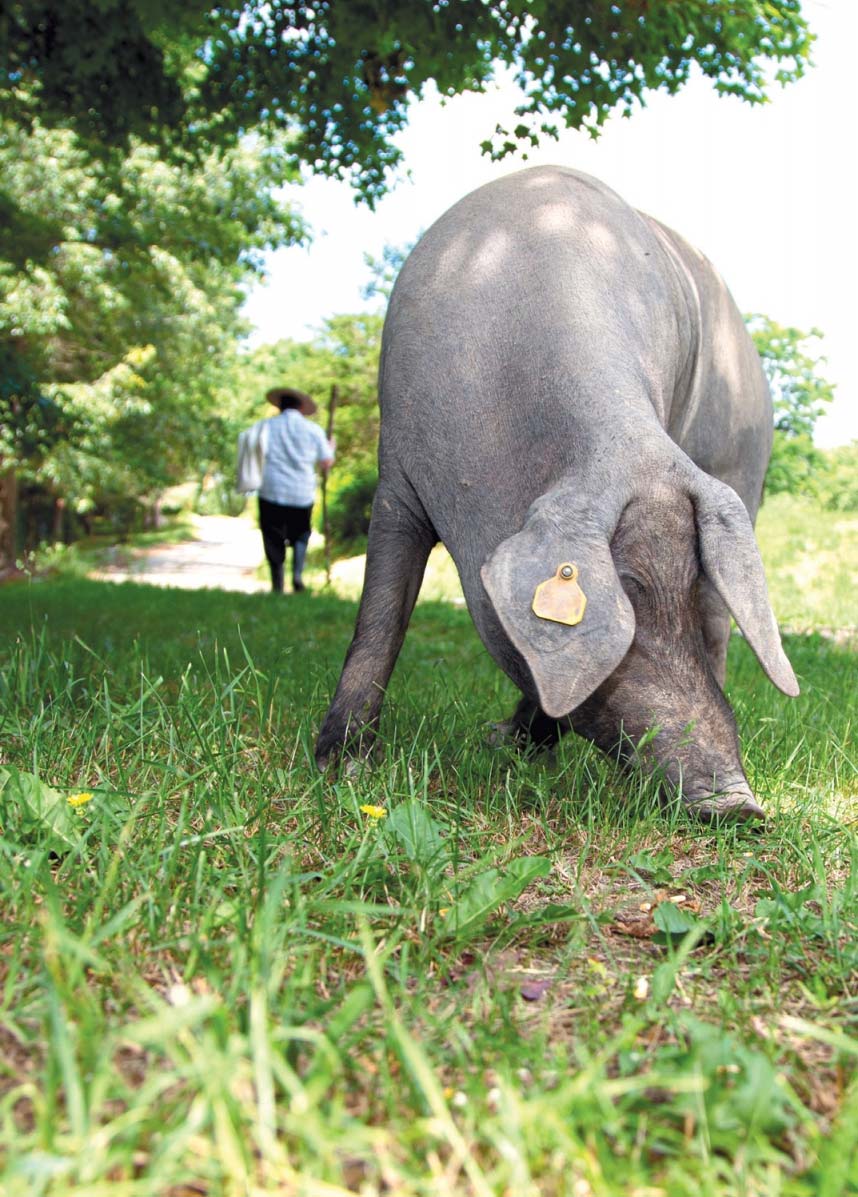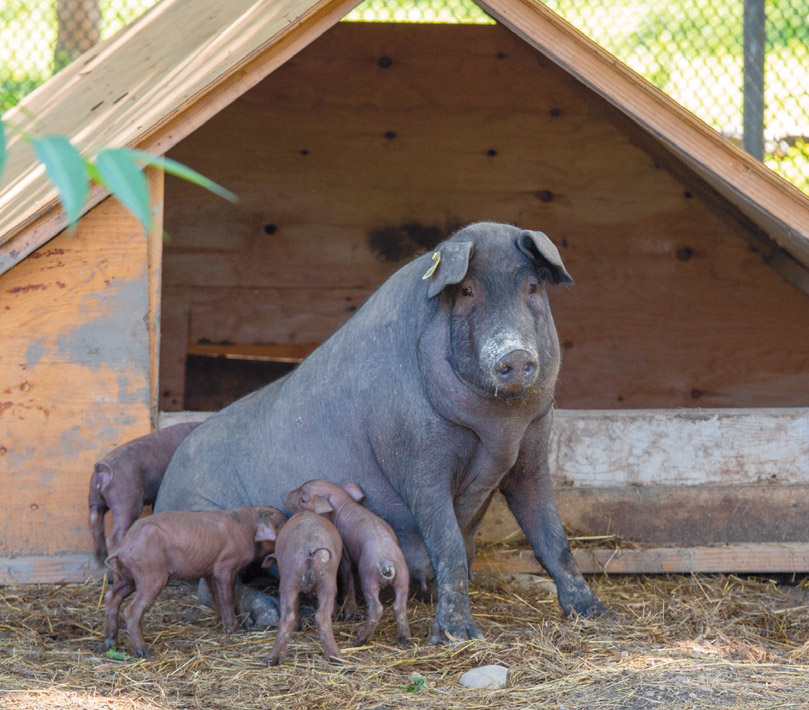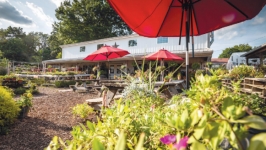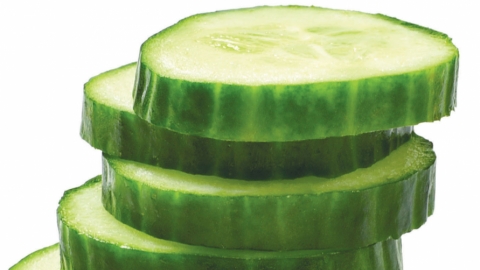Old-World Hogs: One Farmer's Quest to Bring Portugal's Coveted Alentejo Ham to New Jersey
Crafted to stringent quality controls and centuries-old traditions, Italy’s prosciutto di Parma, Spain’s jamón ibérico, and Portugal’s presunto do Alentejo are among Europe’s most coveted artisanal, dry-cured hams. But while the gourmet delicacies from Italy and Spain can be imported for sale in the United States, Portugal’s exquisite presunto cannot. For that reason, Rodrigo Duarte, a Portuguese butcher trained in charcuterie and the science of meat, decided to make his own authentic presunto alentejano right here in the Garden State. But first, he had to make some VIPs—very important pigs—fly.
With permission from the USDA, in 2016 Duarte brought in 10 Alentejo hogs—eight females and two males—purchased from the Portuguese government. Raised in the agriculturally rich Alentejo region, from which the gray-skinned breed gets its name, these hogs—commonly referred to as pata negra (black hoof)—are also used to produce Spain’s highest quality Iberian hams.
Since last year, Duarte has been selling 24-month cured whole legs made from the offspring of that initial herd under his Don Rodrigo brand. The sole ingredients: pork and salt. The label reads “100% Iberian Pure Breed Certified” and, beside an image of the American flag, “Born, harvested, and cured in the U.S.A.” The price: $499 per pound, sliced; $199 per pound for an entire leg. (You read that right: There’s no decimal point in either of those prices.) To date, Duarte has made about 150 legs from his purebreds.
The cost, explains Duarte, reflects the 16 to 24 months spent caring for the hogs—versus the 6- to 9-month life span of pigs used to make most American hams—and the additional two to three years to age the ham. “This is a natural product with no hormones, no antibiotics. Each piece is hand-carved. You’re enjoying a five-year piece of art with centuries of tradition behind it,” he says.
Before Duarte could bring in the Alentejanos, the animals spent 90 days in quarantine at a Portuguese government facility in Vila Nova de São Bento in the Alentejo region, close to the Spanish border. Then, they were trucked some 140 miles to Lisbon for their transatlantic journey on September 16, 2016—aboard a newly inaugurated direct flight between Lisbon and JFK on TAP, the Portuguese airline.
On arrival, the hogs were transported 70 miles north to a quarantine facility in Beacon, NY, where they spent another 30 days before Duarte could claim them. Accompanied by his uncle, Orlando Almeda, who farms in Hope, Duarte was met with a bonus: Despite the rigors of the odyssey, one of the sows had conceived, and had given birth to a litter in Beacon. Today, Duarte’s herd of Alentejanos numbers about 500.
Males selected for butchering are castrated within four days of birth and are called barrows. Within three months of birth, males intended for breeding (boars) are separated from their female siblings (gilts) to prevent in-breeding. Duarte says that to select his boars, he “reads the bodies,” looking for strong animals that are social and not aggressive. “You can tell by the way they behave,” he says.
At a curing facility in Somerset, Portuguese sea salt is applied to the hand-cut, hand-tied hams, and then they are left covered in salt for one day per pound of meat. Afterward, they’re rinsed and hung in refrigeration. Weighing about 25 pounds at the start of the process, the legs lose 35% of their weight during curing.
As the meat cures, “the natural bacteria and enzymes develop unique flavors,” says Duarte. The meat also naturally develops a white mold on the outside, which is rubbed off with olive oil before sale. Each cured leg is stamped to identify the pig from which it came and the date it was salted. “It’s clear what it is. It’s natural, from the farm to your table. You know who made it. That’s priceless,” says Duarte. “Sweetness comes from the natural sugars produced during curing, which also act as a preservative.”
Duarte isn’t worried about finding enough customers willing to pay the hefty price of his products. Rather, he says, “I’m scared that I can’t keep up with the demand. I don’t want to rush the process. If they don’t want to wait, they’ll have to buy something else.”
He estimates that the COVID crisis actually led to a 50-percent increase in sales. “I was shocked. I never thought I’d sell as much ham and charcuterie as I did during the pandemic,” he says. “I think people are more worried about where their food comes from. They want transparency. They want to know the person behind it.”
RODRIGO DUARTE’S ESTEEM FOR OLD-WORLD AGRICULTURAL TRADITIONS INSPIRED HIM TO ADAPT THEM TO A NEW SETTING — A FARM IN SUSSEX COUNTY — TO ENSURE THEIR PRESERVATION.
A Special Breed
A visit to Duarte’s website, USAPataNegra.com, reveals a host of options made from domestic and Alentejano breeds. His specialties include shoulder-cut presunto, wine-cured and bell pepper paste chouriços; salpicão, a sausage he makes from the neck; Porto wine salame; whiskey salame incorporating spirits from All Points West Distillery of Newark; and lard. Inspired by “Romeu e Julieta,” a traditional way to end a Portuguese meal that combines Serra de Estrela, a soft artisanal sheep’s milk cheese, with quince jam and presunto, he also created a Romeu e Julieta salame using those ingredients. All his products, he says, “are made according to ancestral traditions and methods.”
“He has quite a line that we just love. It’s super special. Not only is he right in our backyard, but the quality of what he’s doing is extraordinary,” says Kimberly Yorio, a spokesperson for Kings Supermarkets, which is planning to carry Duarte’s fresh pork, presunto alentejano, and other cured meats.
“We were blown away by his amazing charcuterie,” recalls Einav Gefen, corporate executive chef at Unilever North America in Englewood Cliffs, who met Duarte during a tour of Newark with a team of culinary colleagues. “I look for any excuse to buy and use Rodrigo’s creations.” She also included him in a world culinary arts video series that Unilever sponsors with the Culinary Institute of America.
The look, taste, and tenderness of Duarte’s presunto alentejano are a result of an abundance of IMF—intramuscular fat—that streaks each slice. “The fat through the muscle adds texture. It keeps the meat moist. In a ham it breaks down in a way that allows the muscles to soften and creates flavor. It makes all the difference,” says Jeffrey P. Roberts, author of Salted & Cured: Savoring the Culture, Heritage, and Flavor of America’s Preserved Meats (Chelsea Green, 2017) and an instructor in the culture of food at New England Culinary Institute in Montpelier, VT.
The IMF in Duarte’s hams reflects the pigs’ age and the care they receive at his 12-acre farm in Wantage and the satellite fields he rents in Sussex and Warren counties. Free to forage the grains and grasses that carpet the landscape, the hogs are also fed an ample supply of blueberries, broccoli, bell peppers and other excess locally grown fresh produce, along with leftover artisanal bread from Teixeira’s Bakery in Newark. Duarte also supplements the hogs’ diet with the foods that the breed has traditionally been raised on—chestnuts and acorns from Iberia’s Extremadura region. The taste of the meat from his hogs, he says, “comes from nature, from the farmland, whatever herbs and flavors they eat.” Acorns, in particular, are rich in oleic acid (a monounsaturated omega-9 fatty acid), which penetrates the muscle fibers of the ham as it sweats during the curing process.
Such a diet contrasts with that used in the massive commercial pig farms concentrated in the Midwest, which typically feed their animals a combination of corn and soybean meal under totally confined conditions, notes Michael Westendorf, an agricultural extension agent for livestock and dairy at Rutgers University (which also happens to raise pigs and sell its own pork products on its Cook College campus). The diet that Duarte feeds his hogs is an especially far cry from the garbage-feeding of the 1960s, when refuse from Jersey City and New York was trucked to pig farms in Secaucus, explains Westendorf. “That got to be objectionable because of the odor; the public was ready to move on.”

“THERE WERE NO STUDIES ON HOW THE HOGS WOULD REACT TO NEW JERSEY WEATHER. PORTUGUESE WINTERS ARE MILDER.”
—Rodrigo Duarte
A Niche Market with History, and Legs
Historically, pig farming has played a fairly big role in New Jersey, but in 2017 there were only about 9,000 pigs on 347 farms in New Jersey, according to the USDA National Agricultural Statistics Service. Most of them—about a fifth—are in Burlington County. Specialty breed farmers like Duarte represent a niche market, says Westendorf, “but I think it’s got legs.” The Ossabaw, a descendant of an Iberian pig first brought to the New World by Spanish seafarers, is being raised at Double Brook Farm in Hopewell, he noted, and the Hungarian Mangalitsa is also now locally bred, by Magalitsa by Møsefund, and has become a favorite of area chefs. “There’s definitely a demand for pork products,” says Westendorf. “People love bacon and sausage.”
The increasing demand for sophisticated charcuterie platters has humble roots, however. “This isn’t new. This is how people survived,” says Roberts. “A hog is the most prolific animal in terms of reproduction. You can get two to three litters a year from one sow.” Curing ham was simply a way to ensure a year-round supply of meat in the days before refrigeration. “Meat preservation and specific contributions of new immigrants are part of America’s history and culture,” he noted in his book. “Spanish explorers often traveled with hogs, leaving boars and sows on an island, knowing they would multiply and be available for hunting in a year or two.”
Living off the land is well familiar to Duarte. The seventh of nine siblings, he grew up on his family’s farm in Enxofães in the district of Coimbra, about 140 miles north of Lisbon. They grew their own vegetables and cured their own sausage and ham from the pigs they raised. Apprenticed to a butcher at age 12 in the nearby town of Cantanhede, Duarte used his earnings to finance his culinary and meat science studies in Lisbon and Alentejo and at the Institute of Agrifood Research and Technology, near Barcelona in Spain.
He tried opening his own butcher shop in Portugal, but couldn’t make a go of it. So, in 2002, when a friend who was a general manager at Seabra Foods said there were opportunities for him to ply his craft in Newark’s Portuguese-accented Ironbound community, the 22-year-old Duarte decided to emigrate. For about two years, he worked as head butcher at Seabra’s—where he met Maria Vilaboa, a cashier who would become his wife—and then worked in the meat department at Kings in Short Hills for nine years.
“When I landed, I thought I would learn something new. But then I realized I had something to offer,” he says. Referring to his homeland’s Alentejanos, he adds, “I knew the value of the breed. We didn’t have that here in the US. No Portuguese meat from Portugal.”
US consumers buy $700 million worth of cured meats and hams from Spain, according to Duarte. “Wouldn’t it be nice if part of that $700 million would be made in America and help local farmers?” he says. And so, while working at Kings, he asked himself, “How can I do it?”
At the time, flying in fully grown hogs wasn’t an option. But that didn’t stop the entrepreneurial immigrant. In 2005 he contacted a pig genetics lab in Alentejo and obtained a USDA permit to have pig semen flown in. “The semen didn’t cost anything,” he recalls. “The permit fees came to about $1,000.” He injected the semen into domestic sows on his Uncle Orlando’s farm to create a crossbreed that was at least 50% Alentejano, qualifying the meat for “Pata Negra” designation. Genetic testing showed that piglets born to Duarte’s domestic sows were 85 percent Iberian.
In 2010 he sold dry-cured Pata Negra legs that he’d aged for two years in the cellar of Caseiro e Bom, a specialty food shop that his wife had opened in Newark’s Ironbound, for $199 per pound, sliced. In 2016 and 2017 his Pata Negra presunto was named best dry-cured ham at the Charcuterie Masters competition in Flushing, NY.
Though Duarte still makes presunto from his crossbred hogs, he keeps his purebred Alentejanos on separate properties. According to protocols set by the Associação de Criadores de Porco Alentejano (ACPA), the Association of the Alentejano Pig Breeders in Portugal, all the Alentejanos must be tagged with an ID number and a color indicating their family line. A local veterinarian visits the farm once a month to check on the pigs’ health, and each year a breed technician from the ACPA inspects Duarte’s operations to ensure that they adhere to Portuguese protocols.
Able to identify a specific hog from afar just by its silhouette and behavior, the Portuguese pig whisperer monitors the contour of the animals’ spine for signs of weight loss, which could indicate that they’re being bullied by more aggressive animals keeping them from away from food. “You gotta learn from them. They teach you their needs,” says Duarte. “It’s my life. It’s my passion. If I don’t do it right, I would not have the respect of the government authorities to trust me.”
Respecting Tradition
Speak to Duarte for any length of time, and the word “respect” is a frequent refrain. His esteem for old-world agricultural traditions inspired him to adapt them to a new setting to ensure their preservation.
“Agriculture is dying daily—all over the country, and in Portugal. The barns are falling apart. The young generation don’t see the need for it anymore,” he says. Distaste for meat products, he contends, stems from commercialization and a lack of transparency in food production. Always, he stresses his respect for the animals on which his reputation depends. “I give them good treatment—good food and care.”
Now 41, the affable charcuterie master says that the premature gray streaking his hair is the result of worrying about his herd. “There were no studies on how the hogs would react to New Jersey weather,” he says. “Portuguese winters are milder.” On a chilly overcast day last February, a trio of hogs jointly dug a trench that they lined with twigs and then huddled together in it. “I’ve never seen this before,” says Duarte.
After losing pigs to harsh weather in 2018, he was so upset that he put the boars in separate corrals from the sows so they wouldn’t breed. To protect piglets from the cold, he installed heat-lamp warming chambers for newborns alongside the farrowing stalls where the sows are kept for about two weeks before they’re ready to drop (give birth) during late fall to early spring. This year he built 30 wooden shelters, which he calls cabanas, where in milder weather the sows can drop their litter on the earth beneath their hooves, and easily move about and attend to their piglets, safe from predatory birds.
Although the pigs are free to roam the fenced-in areas of his properties, there are also sheds where they can shelter in inclement weather. In Wantage, they’re tended to by Claudio Silva, a native of the Alentejo region. Duarte calls the farm, where newborns are kept for about six months until they’re weaned, his Pig Intelligence Center. He plans to set up a genetics research facility on site to naturally improve the Alentejano breed, along with a ham museum devoted to the history of ham production and curing.
Ultimately, his goal is to “not just produce hams, but to create a new economy around it,” he says. His plans including converting a barn on his property into a hydroponics facility for growing organic herbs and spices to season his meats. He also hopes to develop a charcuterie training program, possibly in partnership with Bergen Community College (BCC). “We’re going to show the kids where real chefs should begin—on the farm,” he says. Already, he’s conducted sausage-making demonstrations for schoolchildren at his wife’s shop in Newark, and he brought high-school students to tour his Wantage farm as part of an after-school community outreach program headed by Dionisio (Dion) Cucuta, Jr., of Teaneck, executive chef volunteer at BCC’s Bergen Room Bistro.
“I did not come to the United States to take anything from the hog farmers. We want to bring new ideas to the table so we can design needed technology to preserve agriculture and sustain families that have lost the passion for farming,” says Duarte. “We all chase the American dream, right? This is my American dream. Who would’ve thought something like this would happen in New Jersey?”
Pressed about the risky nature of his high-stakes venture, Duarte promptly responds with a broad smile, “I would not go hungry. I would have presuntos and bacon to eat.”
A Portugese Pork Products Primer
Chouriço
Sometimes called linguiça and similar to the Spanish chorizo, a smoke-cured sausage traditionally made with pork shoulder, paprika, garlic, black pepper and salt
Linguiça
Though the name for this dried sausage comes from the Portuguese word for “tongue,” tongue is not among the ingredients
Morcela
Blood sausage
Presunto
Dry-cured ham made from the leg or shoulder; a term used instead of prosciutto when referring to a ham with Portuguese roots
Salpicão
Smoked sausage often made from the loin, though it can also be made from the neck. In Brazil, however, the word refers to a salad containing beef, chicken or turkey and vegetables

WHERE TO BUY AND HOW TO ENJOY PRESUNTO
Easily distinguished from imported Iberian cured hams, Duarte’s legs of presunto made from his Alentejanos are sold with the hoof attached. (No Iberian hams with hoof attached can be imported into the United States.) “Every man cave should have a leg,” says Dionisio (Dion) Cucuta, Jr., of Teaneck, executive chef volunteer at the Bergen Room Bistro on the campus of Bergen Community College in Paramus.
Kings expects to carry Duarte’s presuntos in select stores, along with his other charcuterie and fresh pork. Until then, Duarte’s products can be purchased online at his website, USAPataNegra.com, and at PortugaliaMarketplace.com, as well as at Caseiro e Bom (the shop’s name means “homemade and good”), 70 Pacific Street, Newark (973.900.5385). At Sol- Mar Restaurant in Newark (267 Ferry Street; 973.344.8540), owner Tony Nobre offers Duarte’s presunto as an option on his catering menu.
“The cured ham is a delicacy all by itself. Just like any other great tasting food, it does not need anything else but to be eaten as it is, thinly sliced, with a good glass of wine and maybe cheese,” says Einav Gefen, corporate executive chef at Unilever North America in Englewood Cliffs. Another option, she adds, is to wrap the presunto around Medjool dates and serve with peach jam atop crusty bread.
Gefen also gives high marks to Duarte’s fresh meat. For a dinner for Unilever’s executive leaders, her team of chefs chose Duarte’s fresh Alentejano pork as the only animal protein. Beer-braised, it was served with sunflower-seed risotto, fresh peas, sorrel, mustard, and gravy. “The flavor was perfect— just the right blend of meat and fat—resulting in a juicy, flavorful mouth feel,” she recalls.









